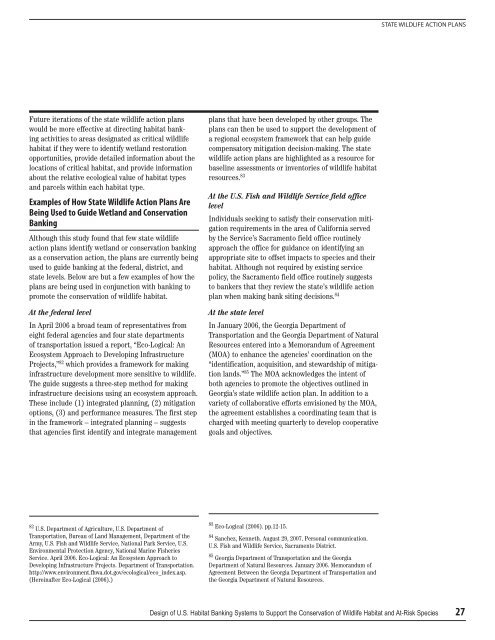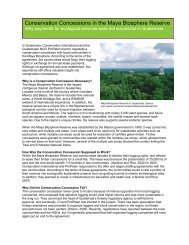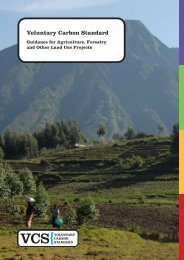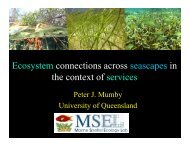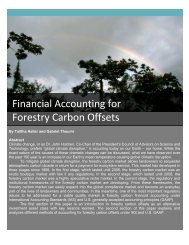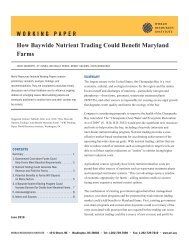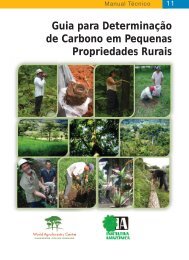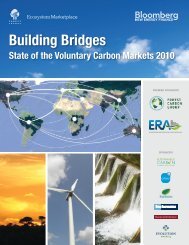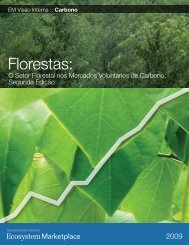Design of US Habitat Banking Systems to Support the Conservation ...
Design of US Habitat Banking Systems to Support the Conservation ...
Design of US Habitat Banking Systems to Support the Conservation ...
Create successful ePaper yourself
Turn your PDF publications into a flip-book with our unique Google optimized e-Paper software.
STATE WILDLIFE ACTION PLANSFuture iterations <strong>of</strong> <strong>the</strong> state wildlife action planswould be more effective at directing habitat bankingactivities <strong>to</strong> areas designated as critical wildlifehabitat if <strong>the</strong>y were <strong>to</strong> identify wetland res<strong>to</strong>rationopportunities, provide detailed information about <strong>the</strong>locations <strong>of</strong> critical habitat, and provide informationabout <strong>the</strong> relative ecological value <strong>of</strong> habitat typesand parcels within each habitat type.Examples <strong>of</strong> How State Wildlife Action Plans AreBeing Used <strong>to</strong> Guide Wetland and <strong>Conservation</strong><strong>Banking</strong>Although this study found that few state wildlifeaction plans identify wetland or conservation bankingas a conservation action, <strong>the</strong> plans are currently beingused <strong>to</strong> guide banking at <strong>the</strong> federal, district, andstate levels. Below are but a few examples <strong>of</strong> how <strong>the</strong>plans are being used in conjunction with banking <strong>to</strong>promote <strong>the</strong> conservation <strong>of</strong> wildlife habitat.At <strong>the</strong> federal levelIn April 2006 a broad team <strong>of</strong> representatives fromeight federal agencies and four state departments<strong>of</strong> transportation issued a report, “Eco-Logical: AnEcosystem Approach <strong>to</strong> Developing InfrastructureProjects,” 82 which provides a framework for makinginfrastructure development more sensitive <strong>to</strong> wildlife.The guide suggests a three-step method for makinginfrastructure decisions using an ecosystem approach.These include (1) integrated planning, (2) mitigationoptions, (3) and performance measures. The first stepin <strong>the</strong> framework – integrated planning – suggeststhat agencies first identify and integrate managementplans that have been developed by o<strong>the</strong>r groups. Theplans can <strong>the</strong>n be used <strong>to</strong> support <strong>the</strong> development <strong>of</strong>a regional ecosystem framework that can help guidecompensa<strong>to</strong>ry mitigation decision-making. The statewildlife action plans are highlighted as a resource forbaseline assessments or inven<strong>to</strong>ries <strong>of</strong> wildlife habitatresources. 83At <strong>the</strong> U.S. Fish and Wildlife Service field <strong>of</strong>ficelevelIndividuals seeking <strong>to</strong> satisfy <strong>the</strong>ir conservation mitigationrequirements in <strong>the</strong> area <strong>of</strong> California servedby <strong>the</strong> Service’s Sacramen<strong>to</strong> field <strong>of</strong>fice routinelyapproach <strong>the</strong> <strong>of</strong>fice for guidance on identifying anappropriate site <strong>to</strong> <strong>of</strong>fset impacts <strong>to</strong> species and <strong>the</strong>irhabitat. Although not required by existing servicepolicy, <strong>the</strong> Sacramen<strong>to</strong> field <strong>of</strong>fice routinely suggests<strong>to</strong> bankers that <strong>the</strong>y review <strong>the</strong> state’s wildlife actionplan when making bank siting decisions. 84At <strong>the</strong> state levelIn January 2006, <strong>the</strong> Georgia Department <strong>of</strong>Transportation and <strong>the</strong> Georgia Department <strong>of</strong> NaturalResources entered in<strong>to</strong> a Memorandum <strong>of</strong> Agreement(MOA) <strong>to</strong> enhance <strong>the</strong> agencies’ coordination on <strong>the</strong>“identification, acquisition, and stewardship <strong>of</strong> mitigationlands.” 85 The MOA acknowledges <strong>the</strong> intent <strong>of</strong>both agencies <strong>to</strong> promote <strong>the</strong> objectives outlined inGeorgia’s state wildlife action plan. In addition <strong>to</strong> avariety <strong>of</strong> collaborative efforts envisioned by <strong>the</strong> MOA,<strong>the</strong> agreement establishes a coordinating team that ischarged with meeting quarterly <strong>to</strong> develop cooperativegoals and objectives.82 U.S. Department <strong>of</strong> Agriculture, U.S. Department <strong>of</strong>Transportation, Bureau <strong>of</strong> Land Management, Department <strong>of</strong> <strong>the</strong>Army, U.S. Fish and Wildlife Service, National Park Service, U.S.Environmental Protection Agency, National Marine FisheriesService. April 2006. Eco-Logical: An Ecosystem Approach <strong>to</strong>Developing Infrastructure Projects. Department <strong>of</strong> Transportation.http://www.environment.fhwa.dot.gov/ecological/eco_index.asp.(Hereinafter Eco-Logical (2006).)83 Eco-Logical (2006). pp.12-15.84 Sanchez, Kenneth. August 29, 2007. Personal communication.U.S. Fish and Wildlife Service, Sacramen<strong>to</strong> District.85 Georgia Department <strong>of</strong> Transportation and <strong>the</strong> GeorgiaDepartment <strong>of</strong> Natural Resources. January 2006. Memorandum <strong>of</strong>Agreement Between <strong>the</strong> Georgia Department <strong>of</strong> Transportation and<strong>the</strong> Georgia Department <strong>of</strong> Natural Resources.<strong>Design</strong> <strong>of</strong> U.S. <strong>Habitat</strong> <strong>Banking</strong> <strong>Systems</strong> <strong>to</strong> <strong>Support</strong> <strong>the</strong> <strong>Conservation</strong> <strong>of</strong> Wildlife <strong>Habitat</strong> and At-Risk Species 27


